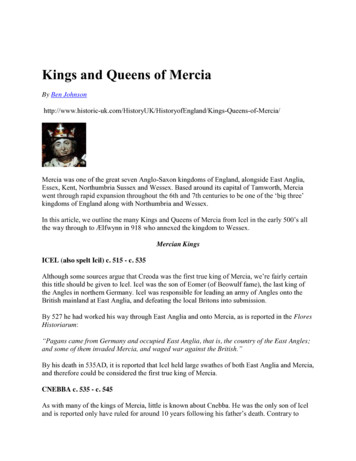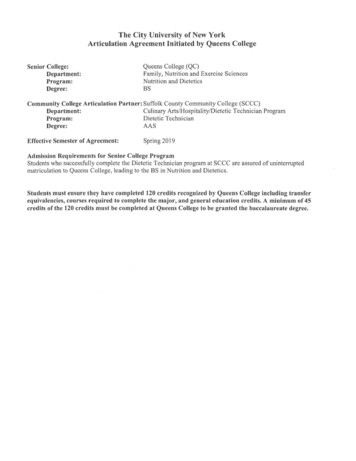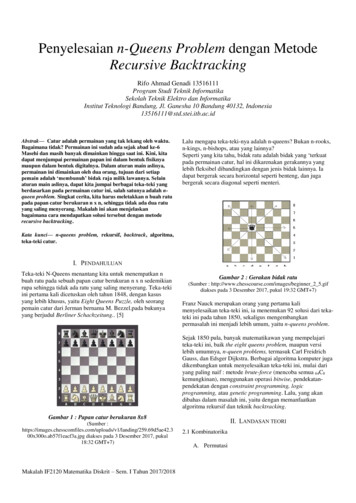
Transcription
Kings and Queens of MerciaBy Ben yofEngland/Kings-Queens-of-Mercia/Mercia was one of the great seven Anglo-Saxon kingdoms of England, alongside East Anglia,Essex, Kent, Northumbria Sussex and Wessex. Based around its capital of Tamworth, Merciawent through rapid expansion throughout the 6th and 7th centuries to be one of the ‘big three’kingdoms of England along with Northumbria and Wessex.In this article, we outline the many Kings and Queens of Mercia from Icel in the early 500’s allthe way through to Ælfwynn in 918 who annexed the kingdom to Wessex.Mercian KingsICEL (also spelt Icil) c. 515 - c. 535Although some sources argue that Creoda was the first true king of Mercia, we’re fairly certainthis title should be given to Icel. Icel was the son of Eomer (of Beowulf fame), the last king ofthe Angles in northern Germany. Icel was responsible for leading an army of Angles onto theBritish mainland at East Anglia, and defeating the local Britons into submission.By 527 he had worked his way through East Anglia and onto Mercia, as is reported in the FloresHistoriarum:“Pagans came from Germany and occupied East Anglia, that is, the country of the East Angles;and some of them invaded Mercia, and waged war against the British.”By his death in 535AD, it is reported that Icel held large swathes of both East Anglia and Mercia,and therefore could be considered the first true king of Mercia.CNEBBA c. 535 - c. 545As with many of the kings of Mercia, little is known about Cnebba. He was the only son of Iceland is reported only have ruled for around 10 years following his father’s death. Contrary to
popular belief, he was not born in Tamworth Fortress (not to be mistaken for Tamworth Castle)as this was not constructed until the end of the 6th century by Cnebba’s grandson, CreodaCYNEWALD c. 545 - c. 580Literally nothing is known about Cynewald, son of Cnebba, not even how long he ruled for!CREODA c. 580 - c. 595Argued by some to be the first true king of Mercia, Creoda was perhaps the first of the Anglekings to securely hold the region of Mercia. What is also likely is that during the previous 50years, his ancestors had found it increasingly difficult to hold both their last remaining vestigesof East Anglia as well as Mercia. As such, Creoda may have decided to cede the remainingeastern parts of his kingdom to King Wuffa (another Angle invader who had interests in the area)in order to better defend the smaller area of Mercia. It is also important to remember that duringthese times of constant seaborne invasions, an inland territory such as Mercia would be easier todefend than a coastal territory such as East Anglia.PYBBA c. 595 - c. 606This ‘busy’ king was said to have had 12 sons and a daughter (although we’re betting not all bythe same woman!). Details about Pybba are sketchy and conflicting, but what is known is that hesuccessfully expanded the Mercian kingdom westwards towards modern day Birmingham andWolverhampton.CEARL c. 606 - c. 625Named by many sources as the king of Mercia during this time (including in Bede’s Historiaecclesiastica gentis Anglorum and Henry of Huntingdon’s Historia Anglorum), Cearl was notactually part of the Mercian royal family. It is not known what his relationship was to Pybba, oreven why he took the throne after his death. What is known is that Cearl quickly becameimpatient of Mercia’s subjugation by its larger and powerful neighbour, the kingdom ofNorthumbria. This came to a head when Cearl was rumoured to have taken part in the Battle ofChester, siding with local British tribes against Æthelfrith of Northumbria. Some scholars arguethat when the British (and possibly Mercians) were defeated at the Battle of Chester, iteffectively ended Cearl’s reign and opened the way for Pybba’s son to retake the throne.PENDA c. 625 - 15th November 655
Son of Pybba, Penda realigned the Mercian throne with the original Icel dynasty. This battlehungry king is remembered for turning Mercia from a second-rate kingdom to the most powerfulin England, overtaking the likes of both Wessex and Northumbria. Perhaps the most famousbattles that Penda led were the Battle of Cirencester (taking the Severn Valley from Wessex) andthe Battle of Hatfield Chase (defeating Edwin of Northumbria, effectively collapsing thekingdom in the process).His most prestigious victory was against a reunited Northumbria at the Battle of Maserfield, nineyears after his success at Hatfield Chase. This victory was to confirm the Mercians as the leadingkingdom in England. During the years that followed, Penda continued fighting both Wessex andEast Anglia to secure even more lands for Mercia.Unfortunately this success was not to last, and at the Battle of Winaed in 655 Penda was finallydefeated by a resurgent Northumbrian army. This battle was important for three reasons; firstly,it restored Northumbrian dominance over the other Anglo-Saxon kingdoms of England.Secondly, Penda’s defeat broke the Mercian kingdom into two. Thirdly, Penda was the last of theAnglo-Saxon kings to have rejected Christianity over Paganism. His defeat effectively markedthe demise of Anglo-Saxon paganism, something that would never be restored.PEADA OF MERCIA (Southern Mercia) 655 - 656OSWIU OF NORTHUMBRIA (Northern Mercia) 655 - 658Following the defeat of Penda at the Battle of Winaed, Mercia effectively fell under the controlof Northumbria. The northern part of the kingdom fell under direct control of Oswiu ofNorthumbria (pictured to the right), whilst the southern part of the kingdom fell to Penda’s son,Paeda, as a form of ‘puppet government’. Paeda’s rule was to be short lived however, as he was‘wickedly’ killed by his own wife during Easter celebrations.
Oswiu of Northumbria ruled over northern Mercia for three years until in 658 three Merciannoblemen banded their armies together and drove him out. Penda’s son, Wulfhere, subsequentlyascended to the Mercian throne and restored control over the kingdom.WULFHERE 658 - 675The first Christian king of Mercia, Wulfhere was a similar ruler to his father, Penda. Upon hissuccession to the throne, he quickly reinstated Mercian power over southern Britain and invadedterritories as far south as the Isle of Wight. Strangely, once he had successfully captured largeportions of south Britain he subsequently handed control over to smaller, local kingdoms such asSussex. He was likely seeking to establish hegemony in the area, as he did not have themanpower to establish and maintain direct control over an extended period. Unlike his fatherhowever, Wulfhere never managed to retake any parts of Northumbria (although he gave it abloody good go in 674!). Wulfhere died of disease in 675.ÆTHELRED I 675 - 704Another son on Penda, Æthelred was a pious and staunchly religious king. He married Oswiu ofNorthumberland’s daughter, and after a hard fought battle with her brother, Ecgfrith, in 679,managed to secure and fix the Mercian border with Northumbria to the line of the River Humber.The drawing of this border effectively put an end to any future incursions by Northumbria.To the south, Æthelred took a much more laissez-faire approach to what was happening. Theonly obviously exception was a short invasion of Kent in 676, to shore up the claim of anotherking in the area.After his wife was murdered in 697, Æthelred continued to rule for another seven years beforeabdicating the throne. He subsequently became a monk at one of the many monasteries he andhis wife had set up, and died some years later.COENRED 704 - 709Son of Wulfhere, the likelihood is that Cœnred was simply too young to succeed to the throne onhis Father’s death, hence the succession of his uncle Æthelred instead. However, on Æthelred’sabdication in 704, Cœnred finally came into power. His short reign was blighted by numerousWelsh incursions into western Mercia, and he eventually abdicated in 709. He ended his years inRome, and like his uncle became a monk.CEOLRED 709 - 716
King Cœnred never married nor had any children, so on his abdication the throne was given toÆthelred’s son, Ceolred. Not much is known about Ceolred, but it is suggested that he wasextremely unpopular with the Church. In fact, in a letter written by St. Boniface to Cœnred’ssuccessor, Æthelbald, he accused the king of “the violation and seduction of nuns and thedestruction of monasteries”. He died at a feast, probably by poisoning.ÆTHELBALD 716 - 757Æthelbald was Ceolred’s cousin, and is widely acknowledged as one of the strongest kings ofMercia. In fact, by the early 730’s he had effective overlordship of the entirety of England southof the Humber. This included the powerful kingdoms of Wessex and Kent. After a long reign,Æthelbald was eventually murdered in 757 by his own bodyguards, although the reason for thisis not known. Today he is buried in a crypt in the village of Repton, South Derbyshire.BEORNRED 757Poor old Beornred no-one even knows how he came to power (he was no apparent relation toany of the kings before him)! The Anglo-Saxon Chronicle writes that Beornred succeededÆthelbald to the throne, but that he held it “but a little while, and unhappily andunprosperously; for King Offa the same year put him to flight, and assumed the government, andheld it 39 years ”OFFA 757 - 29th July 796Much like Æthelbald, Offa was both a strong and enduring king, as well as being renowned forhis overwhelming lust for power. During his 39 year reign he reaffirmed Æthelbald’s claim tothe south of England and built his famous 140 mile dyke along the Welsh border to fortifyMercia against any future Welsh incursions. Offa is often regarded as one of the most powerfulAnglo-Saxon kings to have ever lived. Read more about Offa here.ECGFRITH 29th July – 17th December 796Son of Offa, Ecgfrith ruled for only 141 days before reputedly being assassinated. As the Alcuinof York wrote to a close friend: “The noble youth did not die through his own sins, I believe; itwas the vengeance of the father's blood that fell upon the son.”COENWULF December 796 - 821
After the death of Ecgfrith, there were no direct heirs or successors to the Mercian throne.Instead, the crown went to Coenwulf, a descended of a brother of King Penda.Coenwulf is remembered as being the last king of Mercia to hold dominance across the south ofEngland. He put down numerous rebellions, such as a revolt in Kent by a would-be kingcalled Eadberht Præn. Unfortunately for Eadberht, this uprising was quickly quashed and as apunishment for his treason he was blinded and had some of his limbs dismembered!CEOLWULF I 821 - 823After the death of Coenwulf in 821, the throne was handed to his brother, Ceolwulf.Unfortunately Ceolwulf didn’t have a very good time at it, and is now known as the king that
ushered in the beginning of the Mercian decline. As William of Malmesbury, a prominenthistorian in the 12th century, wrote: “ the kingdom of the Mercians declining, and, if I may usethe expression, nearly lifeless, produced nothing worthy of historical commemoration.”What is worth noting is that Ceolwulf did, in fact for a time at least, take large swathes of thekingdom of Powys from the Welsh and subsequently brought them under Mercian control.Ceolwulf I was deposed in 823 by a relative unknown called Beornwulf.BEORNWULF 823 - 826It would be an understatement to say that Beonwulf wasn’t the most successful of Mercian kings.In fact, Beornwulf is probably the single most important reason why the kingdom of Mercia,after 200 years as the ‘top dog’, became a second rate kingdom once again.The Battle of Ellandun in 825 was the turning point, when Beornwulf decided to attack the kingof Wessex in an area that is now just outside Swindon. He was defeated, and as a consequencethe Mercian sub-kingdoms of Essex and Sussex switched sides to Wessex.To make matters worse, the king of Wessex then decided to invade Kent and subsequently droveout the pro-Mercian king out of the area.Seeing these events, the East Angles also decided to switch sides, leaving the Merican kingdomwithout any of the territories that it had slowly annexed over the previous 200 years. Beornwulfwas understandably not very happy with this turn of events, and quickly headed with his army toEast Anglia to crush the revolt; he was killed in the process.LUDECA 826 - 827Not much is known about Ludeca, not even how he came to power or what his relationship wasto the Mercian royal family. What is known is that a year after his predecessor was killedattempting to subjugate the East Angles, Ludeca went back to try again. Once again, he waskilled in the process.WIGLAF 827 - 839Thought to be a distant relative of Penda, Wiglaf ruled Mercia for twelve interesting years. Thefirst half of his reign saw the entire Mercian kingdom defeated and under the control of the kingof Wessex, Egbert. The second half of his reign saw Wiglaf fight back, recover his kingdom, and
even manage to reclaim Berkshire and large parts of Essex. By the time Wiglaf died in 829,things were looking up for the Mercian kingdom once again but was it to last?WIGMUND 839 - 840It is thought that once Wiglaf died, that he succeeded by his son Wigmund. Unfortunatelynothing more than this is known.WIGSTAN 840Much like his father Wigmund, nothing much is known about Wigstan. What we do know is thathe possibly ruled over Mercia for a very short period of time before being murdered by hissuccessor, Beorhtwulf. He also may have co-ruled with his mother, Ælfflæd.BEORHTWULF 840 - 852Claiming the throne due to his presumed ancestry to Beornwulf (king of Merica 823 – 826),Beorhtwulf’s first order of business was to marry his predecessor’s (Wigstan’s) mother off to hisown son! Over his twelve years on the throne, Beorhtwulf witnessed the first of the Viking raidson British soil. In 842 the Vikings sacked London (at that time still under Mercian control), andagain in 851. However, the later attack forced Beorhtwulf to react, and as his forced reclaimedLondon it pushed the Viking invaders southwards, out through Southwark and into Wessexterritory. Once in Wessex territory, the much more powerful king Æthelwulf swiftly defeatedthem.It is thought that these early Viking invasions brought the kingdoms of Mercia and Wessex muchcloser together, in order to defeat their common enemy.BURGRED 852 - 874The last true independent king of Mercia, Burgred’s relatively long reign was blighted by regularViking invasions. Starting almost immediately after taking the throne, Burgred was forced to allyup with Ethelwulf of Wessex in order to counter attacks from both the Welsh in the west and theVikings in the east.Although Burgred was successful in halting any invasions for almost 20 years, the ‘March of theDanes’ in 874 ultimately proved too much for him to repel and he was subsequently defeated andexpelled from the Mercian kingdom. Burgred then retired to Rome where he later died.CEOLWULF II 874 - 883After the Vikings had successfully driven Burgred from Mercia, they moved to install their ownpuppet king to administer the kingdom. As the Anglo-Saxon Chronicle writes, “[The Danes]gave Ceolwulf, an unwise king's thane, the Mercian kingdom to hold; and he swore oaths tothem, and gave hostages, that it should be ready for them on whatever day they would have it;
and he would be ready with himself, and with all those that would remain with him, at the serviceof the army.”By the end of his reign in 883, Ceolwulf was thought to have also lost the eastern parts of Merciato direct Danish-Viking control. Even the lands that he still held to the west and south wereeffectively sub-kingdoms of Danelaw, and therefore should not be considered a strictly‘independent’ Mercia.ÆTHELRED II 883 - 911With increasing amounts of eastern Mercia coming under Danish-Viking control, Æthelred IIdecided to break ties with Danelaw and instead form an alliance with King Alfred of Wessex.However, this alliance was not a marriage of equals, and as part of the agreement Æthelred hadto effectively cede Mercia to Wessex as a sub-kingdom and promise loyalty to King Alfred. Toseal the pact, he also married Alfred’s daughter, Æthelflaed.Luckily this alliance proved beneficial for the Anglo Saxons, as with Alfred’s help Mercia wasable to reclaim the majority of its eastern kingdom back from the Danish.LADY ÆTHELFLAED 911 - 12th June 918After Æthelred II’s death in 911, the lordship of Mercia fell to his wife (who also happened to bethe daughter of King Alfred of Wessex). Lady Æthelflæd was a keen military strategist, andcarried out repeated attacks both against the Danish in the north-east and the Welsh in the west.LADY ÆELWYNN 918On the death of her mother, Æthelflæd, in 918, Ælfwynn assumed the throne of Mercia.However, this was not to last, as within a few weeks her uncle, King Edward the Elder ofWessex, rode into Mercia and effectively deposed her. Of course, by this time Mercia wasessentially a sub-kingdom of Wessex so Edward knew that he would face little to no resistance.As the Anglo-Saxon Chronicle states, “the daughter of Æthelred, lord of the Mercians, wasdeprived of all dominion over the Mercians, and carried into Wessex, three weeks before midwinter; she was called Ælfwynn."This deposition marked the end of an independent or autonomous Mercia, and instead markedthe beginning of what we now know as the kingdom of England.
Kings and Queens of England & BritainBy Ben Johnson, eensofBritain/There have been 66 recognized monarchs of England and Britain spread over a period of 1500years.English KingsSAXON KINGSEGBERT 827 - 839Egbert (Ecgherht) was the first monarch to establish a stable and extensive rule over all ofAnglo-Saxon England. After returning from exile at the court of Charlemagne in 802, heregained his kingdom of Wessex. Following his conquest of Mercia in 827, he controlled all ofEngland south of the Humber. After further victories in Northumberland and North Wales, he isrecognised by the title Bretwalda (Anglo-Saxon, "ruler of the British". A year before he diedaged almost 70, he defeated a combined force of Danes and Cornish at Hingston Down inCornwall. He is buried at Winchester in Hampshire.AETHELWULF 839-856King of Wessex, son of Egbert and father of Alfred the Great. In 851 Aethelwulf defeated aDanish army at the battle of Oakley while his eldest son Althelstan fought and beat the Danes atsea off the coast of Kent, in what is believed to be the first naval battle. A highly religous man,Athelwulf travelled to Rome with his son Alfred to see the Pope in 855.AETHELBALD 856 - 860The eldest son of Aethelwulf, Æthelbald was born around 834. He was crowned at Kingstonupon-Thames in southwest London, after forcing his father to abdicate upon his return from
pilgrimage to Rome. Following his fathers death in 858, he married his widowed stepmotherJudith, but under pressure from the church the marriage was annulled after only a year. He isburied at Sherbourne Abbey in Dorset.AETHELBERT 860 - 866Became king following the death of his brother Æthelbald. Like his brother and his father,Aethelbert (pictured to the right) was crowned at Kingston-Upon-Thames. Shortly after hissuccession a Danish army landed and sacked Winchester before being defeated by the Saxons. In865 the Viking Great Heathen Army landed in East Anglia and swept across England. He isburied at Sherborne Abbey.AETHELRED I 866 - 871Aethelred succeeded his brother Aethelbert. His reign was one long struggle with the Danes whohad occupied York in 866, establishing the Viking kingdom of Yorvik. When the Danish Armymoved south Wessex itself was threatened, and so together with his brother Alfred, they foughtseveral battles with the Vikings at Reading, Ashdown and Basing. Aethelred suffered seriousinjuries during the next major battle at Meretun in Hampshire; he died of his wounds shortlyafter at Witchampton in Dorset, where he was buried.ALFRED THE GREAT 871 - 899 - son of AETHELWULFBorn at Wantage in Berkshire around 849, Alfred was well educated and is said to have visitedRome on two occasions. He had proven himself to be a strong leader in many battles, and as awise ruler managed to secure five uneasy years of peace with the Danes, before they attackedWessex again in 877. Alfred was forced to retreat to a small island in the Somerset Levels and itwas from here that he masterminded his comeback, perhaps 'burning the cakes' as a consequence.With major victories at Edington, Rochester and London, Alfred established Saxon Christian ruleover first Wessex, and then on to most of England. To secure his hard won boundaries Alfredfounded a permanent army and an embryonic Royal Navy. To secure his place in history, hebegan the Anglo-Saxon Chronicles.EDWARD (The Elder) 899 - 924Succeeded his father Alfred the Great. Edward retook southeast England and the Midlands fromthe Danes. Following the the death of his sister Aethelflaed of Mercia, Edward unites thekingdoms of Wessex and Mercia. In 923, the Anglo-Saxon Chronicles record that the ScottishKing Constantine II recognises Edward as "father and lord". The following year, Edward iskilled in a battle against the Welsh near Chester. His body is returned to Winchester for burial.
ATHELSTAN 924 - 939Son of Edward the Elder, Athelstan extended the boundaries of his kingdom at the Battle ofBrunanburh in 937. In what is said to be one of the bloodiest battles ever fought on British soil,Athelstan defeated a combined army of Scots, Celts, Danes and Vikings, claiming the title ofKing of all Britain. The battle saw for the first time individual Anglo-Saxon kingdoms beingbrought together to create a single and unified England. Athelstan is buried in Malmesbury,Wiltshire.EDMUND 939 - 946Succeeded his half-bother Athelastan as king at the tender age of 18, having already foughtalongside him at the Batlle of Brunanburh two years earlier. He re-established Anglo-Saxoncontrol over northern England, which had fallen back under Scandanavian rule following thedeath of Athelstan. Aged just 25, and whilst celebrating the feast of Augustine, Edmund wasstabbed by a robber in his royal hall at Pucklechurch near Bath. His two sons, Eadwig and Edgar,were perhaps considered too young to become kings.EADRED 946 - 955The son of Edward the Elder by his third marriage to Eadgifu, Eadred succeeded his brotherEdmund following his premature death. He followed in the family tradition of defeatingNorsemen, expelling the last Scandanavian King of York, Eric Bloodaxe, in 954. A deeplyreligious man, Eadred suffered a serious stomach ailment that would eventually prove fatal.Eadred died in his early 30s, unmarried and without an heir, at Frome in Somerset. He is buriedin Winchester.EADWIG 955 - 959The eldest son of Edmund I, Eadwig was about 16 when he was crowned king at Kingston-uponThames in southeast London. Legend has it that his coronation had to be delayed to allow BishopDunstan to prise Eadwig from his bed, and from between the arms of his "strumpet" and thestrumpets' mother. Perhaps unimpressed by the interruption, Eadwig had Dunstan exiled toFrance. Eadwig died in Gloucester when he was just 20, the circumstances of his death are notrecorded.EDGAR 959 - 975The youngest son of Edmund I, Edgar had been in dispute with his brother concerningsuccession to the throne for some years. Following Eadwig's mysterious death, Edgarimmediately recalled Dunstan from exile, making him Archbishop of Canterbury as well as hispersonal advisor. Following his carefully planned (by Dunstan) coronation in Bath in 973, Edgarmarched his army to Chester, to be met by six kings of Britain. The kings, including the King ofScots, King of Strathclyde and various princes of Wales, are said to have signalled theirallegience to Edgar by rowing him in his state barge accross the River Dee.EDWARD THE MARTYR 975 - 978Eldest son of Edgar, Edward was crowned king when aged just 12. Although supported byArchbishop Dunstan, his claim to the throne was contested by supporters of his much youngerhalf-brother Aethelred. The resulting dispute between rival factions within the church andnobility almost led to civil war in England. Edward's short reign ended when he was murdered at
Corfe Castle by followers of Aethelred, after just two and half years as king. The title 'martyr'was a consequence of him being seen as a victim of his stepmother's ambitions for her own sonAethelred.AETHELRED II THE UNREADY 978 - 1016Aethelred was unable to organise resistance against the Danes, earning him the nickname'unready', or 'badly advised'. He became king aged about 10, but fled to Normandy in 1013 whenSweyn Forkbeard, King of the Danes invaded England.Sweyn was pronounced King of England on Christmas Day 1013 and made his capital atGainsborough, Lincolnshire. He died just 5 weeks later.Aethelred returned in 1014 after Sweyn's death. The remainder of Aethelred's reign was one of aconstant state of war with Sweyn's son Canute.EDMUND II IRONSIDE 1016 - 1016The son of Aethelred II, Edmund had led the resistance to Canute's invasion of England since1015. Following the death of his father, he was chosen king by the good folk of London. TheWitan (the king's council) however elected Canute. Following his defeat at the Battle ofAssandun, Aethelred made a pact with Canute to divide the kingdom between them. Edmunddied later that year, probably assassinated.CANUTE (CNUT THE GREAT) THE DANE 1016 - 1035Canute became king of all England following the death of Edmund II. The son of SweynForkbeard, he ruled well and gained favour with his English subjects by sending most of hisarmy back to Denmark. In 1017, Canute married Emma of Normandy, the widow of Aethelred IIand divided England into the four earldoms of East Anglia, Mercia, Northumbria and Wessex.Perhaps inspired by his pilgrimage to Rome in 1027, legend has it that he wanted to demonstrateto his subjects that as a king he was not a god, he ordered the tide not to come in, knowing thiswould fail.HAROLD I 1035 - 1040Also known as Harold Harefoot, in recognition of his speed and skill as a hunter. Harold was theillegitimate son of Canute, he claimed the English crown on the death of his father whilst his
half-brother Harthacanute, the rightful heir, was in Denmark fighting to protect his Danishkingdom. Harold died three years into his reign, just weeks before Harthacanute was due toinvade England with an army of Danes. He was buried in Westminster Abbey beforeHarthacanute had his body dug up, beheaded, and thrown into the Thames. His bits were latergathered and re-buried at St. Clement Danes in London.HARTHACANUTE 1040 - 1042The son of Cnut the Great and Emma of Normandy, Harthacanute sailed to England with hismother, accompanied by a fleet of 62 warships, and was immediately accepted as king. Perhapsto appease his mother, the year before he died Harthacanute invited his half-brother Edward,Emma's son from her first marriage to Aethelred the Unready, back from exile in Normandy.Harthacanute died at a wedding whilst toasting the health of the bride; he was aged just 24 andwas the last Danish king to rule EnglandEDWARD THE CONFESSOR 1042-1066Following the death of Harthacanute, Edward restored the rule of the House of Wessex to theEnglish throne. A deeply pious and religious man, he presided over the rebuilding ofWestminster Abbey, leaving much of the running of the country to Earl Godwin and his sonHarold. Edward died childless, eight days after the building work on Westminster Abbey hadfinished. With no natural successor, England was faced with a power struggle for control of thethrone.HAROLD II 1066Despite having no royal bloodline, Harold Godwin was elected king by the Witan (a council ofhigh ranking nobles and religious leaders), following the death of Edward the Confessor. Theelection result failed to meet with the approval of one William, Duke of Normandy, who claimedthat his relative Edward had promised the throne to him several years earlier. Harold defeated aninvading Norwegian army at the Battle of Stamford Bridge in Yorkshire, then marched south toconfront William of Normandy who had landed his forces in Sussex. The death of Harold at theBattle Of Hastings meant the end of the English Anglo-Saxon kings and the beginning of theNormans.NORMAN KINGSWILLIAM I (The Conqueror) 1066- 1087Also known as William the Bastard (but not normally to his face!), he was the illigitimate son ofRobert the Devil, whom he succeeded as Duke of Normandy in 1035. William came to Englandfrom Normandy, claiming that his second cousin Edward the Confessor had promised him thethrone, and defeated Harold II at the Battle of Hastings on 14th October 1066. In 1085 the
Domesday Survey was begun and all of England was recorded, so William knew exactly whathis new kingdom contained and how much tax he could raise in order to fund his armies.William died at Rouen after a fall from his horse whilst beseiging the French city of Nantes. Heis buried at Caen.WILLIAM II (Rufus) 1087- 1100William was not a popular king, given to extravagance and cruelty. He never married and waskilled in the New Forest by a stray arrow whilst out hunting, maybe accidentally, or possibly shotdeliberately on the instructions of his younger brother Henry. Walter Tyrrell, one of the huntingparty, was blamed for the deed. The Rufus Stone in The New Forest, Hampshire, marks the spotwhere he fell.HENRY I 1100-1135Henry Beauclerc was the fourth and youngest son of William I. Well educated, he founded a zooat Woodstock in Oxfordshire to study animals. He was called the 'Lion of Justice' as he gaveEngland good laws, even if the punishments were ferocious. His two sons were drowned in theWhite Ship so his daughter Matilda was made his successor. She was married to GeoffreyPlantagenet. When Henry died of food poisoning, the Council considered a woman unfit to ruleand so offered the th
In this article, we outline the many Kings and Queens of Mercia from Icel in the early 500’s all the way through to Ælfwynn in 918 who annexed the kingdom to Wessex. Mercian Kings ICEL (also spelt Icil) c. 515 - c. 535 Although some sources argue that Creod










